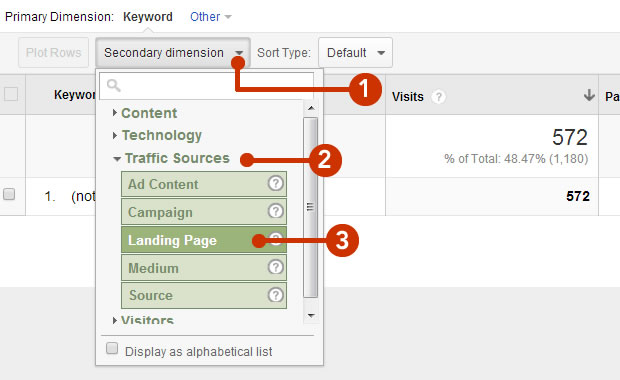Improve Your Data Evaluation with Secondary Dimension in Google Analytics
Improve Your Data Evaluation with Secondary Dimension in Google Analytics
Blog Article
Transform Your Analytics Method With Secondary Measurement in Google Analytics
By incorporating secondary dimensions into information analysis, a new layer of insights emerges, dropping light on detailed customer habits and communications. The calculated application of second measurements holds the essential to unlocking a prize trove of vital info that can transform how services analyze and act upon their information.
Comprehending Secondary Measurements in Google Analytics
Additional measurements in Google Analytics supply additional context to primary data by allowing individuals to assess metrics across a second measurement, supplying much deeper insights right into user actions and interactions on an internet site. Secondary Dimension in Google Analytics. While main dimensions give fundamental data factors such as pageviews, bounce price, and session period, second measurements provide a more thorough sight by segmenting the main information additionally. This division allows customers to evaluate metrics in combination with another dimension, such as website traffic resources, demographics, or individual actions
Advantages of Utilizing Second Dimensions
Utilizing second measurements in Google Analytics offers a tactical advantage by boosting the depth of analysis and offering an extra thorough understanding of customer interactions and behavior on a website. By integrating additional measurements, analysts can get useful understandings right into the performance of certain segments or variables within their data. This allows a more comprehensive assessment of individual behavior beyond surface-level metrics, permitting a much deeper expedition of the elements affecting customer interaction and conversions.

Exactly How to Execute Secondary Measurements
When integrating additional measurements in Google Analytics, one essential action is to choose the relevant metrics and dimensions to enrich the analysis procedure. Clicking on this switch will certainly open up a drop-down food selection listing different dimensions that can be added to your main measurement for deeper understandings.
After picking the proper additional dimension, such as 'Source/Medium' or 'Gadget Category,' Google Analytics will certainly show the data in a more thorough format, allowing you to cross-analyze various aspects of user behavior. Keep in mind to experiment with various mixes of primary and additional measurements to discover useful patterns and fads that can inform your marketing methods. By implementing second measurements attentively, you can get a much more extensive understanding of your site or application efficiency and make data-driven decisions to enhance your digital existence.
Studying Data With Additional Measurements
Boost your information evaluation in Google Analytics by integrating additional measurements to dive much deeper right into customer habits patterns and maximize your digital advertising techniques properly - Secondary Dimension in Google Analytics. By adding second dimensions to your key information, have a peek here you can gain useful understandings that can assist you make informed decisions concerning your website or app performance
Analyzing data with additional measurements enables you to sector your main data further, providing an extra detailed sight of customer interactions. For example, combining the primary measurement of 'source/medium' with an additional dimension like 'touchdown web page' can expose which particular web pages are driving website traffic from various resources. This details can be instrumental in refining your material technique or maximizing your ad campaign to enhance conversions.
Additionally, utilizing second dimensions enables you to identify more connections between different metrics, aiding you comprehend the influence of various aspects on customer habits. Whether it's analyzing demographics together with customer engagement metrics or device classifications with conversion rates, additional dimensions encourage you to reveal covert patterns and patterns that can lead your advertising and marketing initiatives.
Maximizing Performance With Additional Measurements
To enhance the performance of data evaluation and decision-making in Google Analytics, including second dimensions is vital to maximizing efficiency metrics and getting deeper insights into user actions patterns. By using second measurements, analysts can delve past surface-level data and discover important correlations that may or else go undetected. This optimization method allows services to tailor their marketing initiatives more successfully, identify areas for enhancement in site usability, and improve total individual experience.
Second dimensions provide an even more detailed sight of user interactions by supplying additional context to primary information metrics. For instance, pairing the main measurement of 'landing web page' with a secondary measurement like 'tool group' can reveal whether particular tools are more probable to drive interaction on certain touchdown pages. This understanding can notify receptive design improvements or targeted advertising techniques to improve performance.

Verdict
To conclude, the assimilation of secondary measurements in Google Analytics supplies services with an effective tool to improve their analytics approach. Secondary Dimension in Google Analytics. By diving deeper right into user habits and interactions, online marketers can reveal beneficial understandings that can drive click to investigate performance optimization and enhance the general user experience. Leveraging second dimensions permits an extra detailed evaluation of data, leading to even more educated decision-making and tailored advertising and marketing efforts
Second measurements in Google Analytics give additional context to main information by enabling customers to evaluate metrics throughout a 2nd dimension, providing much deeper understandings right into individual habits and interactions on a site. While main dimensions offer basic data factors such as pageviews, bounce rate, and session period, additional dimensions provide a more comprehensive view by segmenting the main data further.One of the key benefits of making use of second measurements is the capacity to uncover relationships and patterns that might not be promptly obvious when assessing data with main measurements alone.When incorporating additional dimensions in Google Analytics, one crucial step is to select the appropriate metrics and measurements to improve the analysis procedure. Matching the main measurement of 'landing web page' with an additional measurement like 'tool classification' can disclose whether specific devices are a lot more most likely to drive engagement on certain touchdown web pages.
Report this page